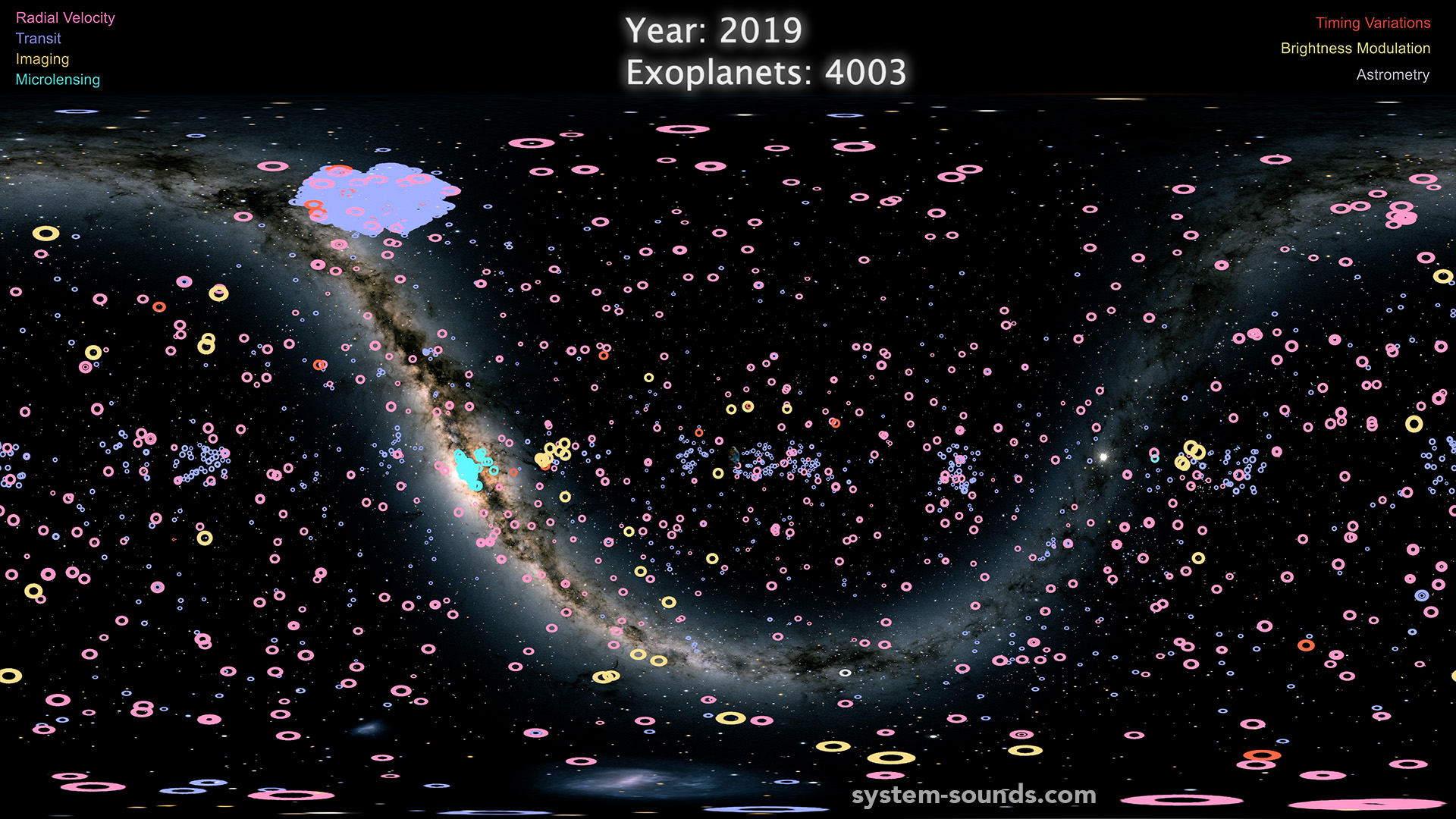4000 Exoplanets
Watch and listen to the discovery of the first 4000 exoplanets
On June 13, 2019, the official count of known exoplanets passed 4000! To celebrate, we have animated their discoveries in time and converted them into music. A circle appears at the position of each exoplanet as it is discovered with a colour that indicates which method was used to find it (see below). The size of the circle indicates the relative size of the planet’s orbit and the pitch of the note indicates the relative orbital period of the planet. Planets with longer orbital periods (lower orbital frequencies) are heard as low notes and planets with shorter orbital periods (higher orbital frequencies) are heard as higher notes. The volume and intensity of the note depends on how many planets with similar orbital periods were announced at the same time. The discovery of a single planet will be quiet and soft while the discovery of many planets with similar periods is loud and intense. The quiet background hum is created by converting the colours of bright stars that appear in the Milky Way into sound.
Radial Velocity (Pink), Transit (Purple), Imaging (Orange), Microlensing (Cyan), Timing Variations (pulsar, transit, eclipse, pulsation) (Red), Orbital brightness Modulation (Yellow), Astrometry (Grey)
This was featured as the Astronomy Picture of the Day on July 10, 2019 and has been viewed by over 1 million people on Youtube and Instagram! Check out the fantastic article about it by Phil Plait for Bad Astronomy and an excellent video explanation by Anton Petrov!

Some of the many interesting things that are visible (and audible) in the video:
- Jan. 1992: first exoplanets confirmed, a pair orbiting a pulsar (PSR B1257+12). These were found by looking at the variations they caused in the timing of the pulsars pulses.
- Apr. 1994: a third planet is found orbiting the same pulsar
- Nov. 1995: first exoplanet found orbiting a normal star, a hot Jupiter named 51 Pegasi b. Its extremely short orbital period of 4.23 days is heard as a high note.
- Most early detections used the radial velocity method (pink). These were typically large planets on small orbits.
- Later on, the transit method (purple) took the lead with the Kepler telescope finding over 2600 exoplanets.
- Kepler stared in a particular direction during its first run so all the planets it found during this time are in the same narrow patch, the Kepler field of view (upper left)
- Feb. 2014: 715 new Kepler planets announced
- May 2016: 1284 new Kepler planets announced
- 2014: Kepler begins its ‘second light’, called K2. Planets found by the K2 mission are in small patches along the ecliptic, the plane of the Earth’s orbit around the Sun (eye level in the 360° version and horizontally across the middle of the frame in the full sky version).
- Planets found with gravitational microlensing (cyan) appear near the galactic center since this method relies on having many background stars so that some will align with closer planetary systems.
- Planets found with direct imaging (orange) have very large orbits (long orbital periods and low notes) since this is what allows them to be distinguished from their brighter stars.
- This is just the start! The TESS mission which is currently collecting data is expected to find 20 000 new exoplanets over the next few years. What will that sound like?
Banner image by ESO/M. Kornmesser.
